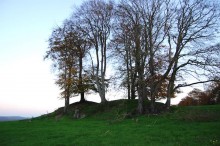|
|
|
|
Corton Long BarrowLong Barrow
|
||||||||||||||||||||||||
|
|
|
Images (click to view fullsize) |
|




|
Fieldnotes |
|
|
A neolithic long barrow on the West Wiltshire Downs. 19th century excavations revealed eight skeletons and two cremation burials in an urn. The site can be best seen from an old rutted trackway heading up to the Ridgeway from Model Farm, to the west of Corton. There's no direct access, but there's a good gap in the tree cover along the track just past the barrow, where you can look back at it. The barrow itself, as with many others, has trees growing on top of it, but is surrounded by corn, so at least has some visual integrity. |
Posted by awrc 15th June 2004ce |
Miscellaneous |
|
|
Details of Long Barrow on Pastscape A long barrow described as Boyton 1 by Goddard and excavated by Cunnington in 1801-04 locating eight primary inhumations at the eastern end and a secondary cremation. Field investigations in 1968 and 1975 found the barrow multilated with a maximum height, at the eastern end, of 2.4 metres. Its appearance, in profile, was of confluent bowl barrows, the result of the early excavations. (ST 93084033) Corton Long Barrow (GT) (1) Corton Long Barrow was 216 feet long, 25 feet wide and 9 feet high in 1804 but is reduced in length and spread in width by ploughing. It is orientated east west, and was excavated by Cunnington, in 1801 and 1804. Beneath a cairn at the east end was a primary deposit of 8 skeletons placed between two empty pits; a secondary inurned cremation was found at the west end. (2-3) A mutilated long barrow with a maximum height, at its eastern end, of 2.4 metres. The appearance, in profile, is of confluent bowl barrows but this is apparently the result of the early excavations. Surveyed at 1:2500. (4) No change; report of 6.11.68 correct. (5) Originally recorded as Boyton 1 by Goddard (6). Corton Long barrow, ST 28 (Kinnes) the inhumations were located at the eastern end covered by a cairn of flint and chalk rubble with a large stone at the apex. The composition of the mound is unknown. (7) -------------------------------------------------------------------------------- SOURCE TEXT -------------------------------------------------------------------------------- ( 1) Ordnance Survey Map (Scale / Date) OS 6" 1961 ( 2) edited by R B Pugh and Elizabeth Crittall 1957 A history of Wiltshire: volume 1, part 1 The Victoria history of the counties of England Page(s)138 ( 3) Society of Antiquaries of London Archaeologia : or miscellaneous tracts relating to antiquity 15, 1806 Page(s)338 ( 4) Field Investigators Comments F1 ANK 06-NOV-68 ( 5) Field Investigators Comments F2 MJF 26-JUN-75 ( 6) The Wiltshire archaeological and natural history magazine 38, 1913-14 Page(s)207, 386 ( 7) General reference British Museum Occassional Paper 52, Non Megalithic Long barrows and allied structures in the British Neolithic. 1992, 10, 25 (I. Kinnes) |
 Posted by Chance
Posted by Chance8th July 2012ce |

